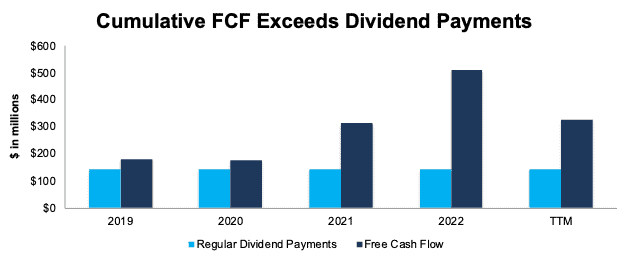Six new stocks made October’s Dividend Growth Stocks Model Portfolio, which was made available to members on October 27, 2023.
Recap from September’s Picks
On a price return basis, our Dividend Growth Stocks Model Portfolio (-4.2%) underperformed the S&P 500 (-2.6%) by 1.6% from September 28, 2023 through October 25, 2023. On a total return basis, the Model Portfolio (-4.0%) underperformed the S&P 500 (-2.6%) by 1.4% over the same time. The best performing stock was up 9%. Overall, 12 out of 30 Dividend Growth stocks outperformed their respective benchmarks (S&P 500 and Russell 2000) from September 28, 2023 through October 25, 2023.
This report leverages our cutting-edge Robo-Analyst technology to deliver proven-superior[1] fundamental research and support more cost-effective fulfillment of the fiduciary duty of care.
This Model Portfolio mimics an “All Cap Blend” style with a focus on dividend growth. Selected stocks earn an Attractive or Very Attractive rating, generate positive free cash flow (FCF) and economic earnings, offer a current dividend yield >1%, and have a 5+ year track record of consecutive dividend growth. This Model Portfolio is designed for investors who favor long-term capital appreciation over current income, but still appreciate the power of growing dividends.
Featured Stock for October: BOK Financial Corp (BOKF: $66/share)
BOK Financial (BOKF) is the featured stock in October’s Dividend Growth Stocks Model Portfolio.
BOK Financial has grown revenue by 10% compounded annually and net operating profit after tax (NOPAT) by 15% compounded annually since 2016. The company’s NOPAT margin increased from 18% in 2016 to 24% over the TTM, while invested capital turns rose from 0.4 to 0.5 over the same time. Higher invested capital turns and NOPAT margins drive return on invested capital (ROIC) from 7% in 2016 to 11% in TTM.
Figure 1: BOK Financial’s Revenue & NOPAT Since 2016
Sources: New Constructs, LLC and company filings
Free Cash Flow Supports Regular Dividend Payments
BOK Financial has increased its regular dividend from $0.43/share in 3Q16 to $0.54/share in 3Q23. The current quarterly dividend, when annualized, equals $2.16/share and provides a 3.3% dividend yield.
More importantly, BOK Financial’s free cash flow (FCF) easily exceeds its regular dividend payments. From 2019 through 2Q23, BOK Financial generated $1.3 billion (28% of current enterprise value) in FCF while paying $648 million in dividends. See Figure 2.
Figure 2: BOK Financial’s FCF vs. Regular Dividends Since 2019
Sources: New Constructs, LLC and company filings
Companies with FCF well above dividend payments provide higher-quality dividend growth opportunities. On the other hand, dividends that exceed FCF cannot be trusted to grow or even be maintained.
BOKF Is Undervalued
At its current price of $66/share, BOK Financial has a price-to-economic book value (PEBV) ratio of 0.5. This ratio means the market expects BOK Financial’s NOPAT to permanently fall 50% from current levels. This expectation seems overly pessimistic given that BOK Financial has grown NOPAT by 7% compounded annually since 2012 and 9% compounded annually since 1998.
Even if BOK Financial’s NOPAT margin falls to 18% (BOK Financials’ lowest NOPAT margin in the last decade), and revenue grows just 2% compounded annually through 2032, the stock would be worth $85/share today – a 28% upside. See the math behind this reverse DCF scenario. In this scenario, BOK Financials’ NOPAT would actually decline 1% compounded annually through 2032. Should the company’s NOPAT grow more in line with historical growth rates, the stock has even more upside.
Add in BOK Financial’s 3.3% dividend yield and a history of dividend growth, and it’s clear why this stock is in October’s Dividend Growth Stocks Model Portfolio.
Critical Details Found in Financial Filings by Our Robo-Analyst Technology
Below are specifics on the adjustments we make based on Robo-Analyst findings in BOK Financial’s 10-K and 10-Qs:
Income Statement: we made $43 million in adjustments with a net effect of removing $13 million in non-operating income (<1% of revenue). Clients can see all adjustments made to BOK Financial’s income statement on the GAAP Reconciliation tab on the Ratings page on our website.
Balance Sheet: we made $1.6 billion in adjustments to calculate invested capital with a net increase of $907 million. The most notable adjustment was $837 million (16% of reported net assets) in other comprehensive income. See all adjustments made to BOK Financial’s balance sheet on the GAAP Reconciliation tab on the Ratings page on our website.
Valuation: we made $188 million in adjustments, all of which decreased shareholder value. The most notable adjustment to shareholder value was $28 million in operating leases. This adjustment represents 1% of BOK Financial’s market value. See all adjustments to BOK Financial’s valuation on the GAAP Reconciliation tab on the Ratings page on our website.
This article was originally published on November 2, 2023.
Disclosure: David Trainer, Kyle Guske II, Italo Mendonça, and Hakan Salt receive no compensation to write about any specific stock, style, or theme.
Questions on this report or others? Join our Society of Intelligent Investors and connect with us directly.
[1] Our research utilizes our Core Earnings, a more reliable measure of profits, as proven in Core Earnings: New Data & Evidence, written by professors at Harvard Business School (HBS) & MIT Sloan and published in The Journal of Financial Economics.


